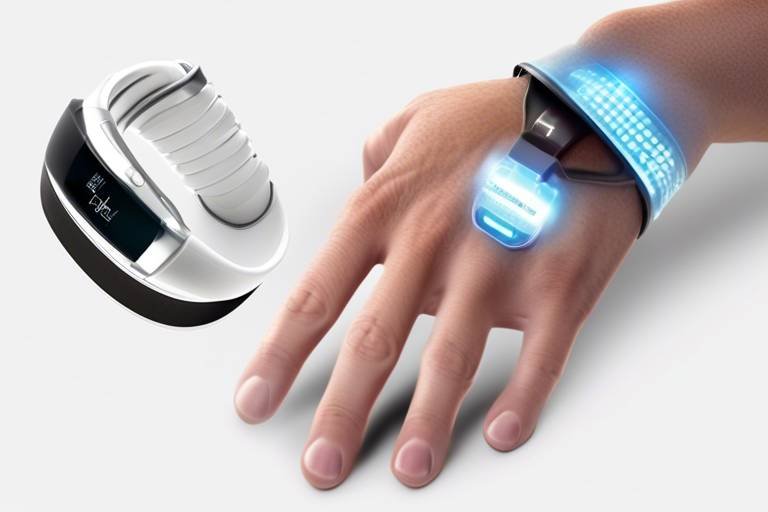The Future of Digital Therapeutics for Chronic Illness
As we stand on the brink of a healthcare revolution, the concept of digital therapeutics is rapidly gaining momentum. Imagine a world where managing chronic illnesses is as easy as tapping a few buttons on your smartphone. Well, that world is closer than you think! Digital therapeutics are not just a passing trend; they are poised to transform how we approach chronic illness management. With advancements in technology, we are witnessing a shift from traditional treatment methods to more innovative, tech-driven solutions that empower patients, healthcare providers, and technology developers alike.
So, what exactly are digital therapeutics? These are evidence-based interventions delivered through software that aim to prevent, manage, or treat medical disorders. Unlike conventional treatments that often rely on medications or physical therapies, digital therapeutics leverage the power of technology to provide tailored solutions that can adapt to the unique needs of each patient. This makes them particularly effective for chronic conditions, where ongoing management is crucial. As we dive deeper into this topic, we'll explore how these digital solutions are already making waves in the healthcare sector and what the future holds.
In the realm of chronic illness, conditions like diabetes, hypertension, and mental health disorders have found a new ally in digital therapeutics. The potential for these technologies to improve patient outcomes is immense. For instance, consider diabetes management; with the integration of digital tools, patients can now monitor their blood sugar levels in real-time, receive personalized feedback, and even connect with healthcare professionals without leaving their homes. This level of engagement is not just convenient; it encourages patients to take an active role in their health, which can lead to better management of their condition.
But it doesn't stop there. The integration of wearable technology has revolutionized the way we approach diabetes care. Devices that continuously monitor glucose levels provide patients with critical information at their fingertips, allowing them to make informed decisions about their health. Combine this with telehealth services, and you've got a powerful system that enhances the effectiveness of diabetes management programs. Patients are no longer isolated in their struggles; they have access to a support network that can guide them through their journey.
As we venture further into the future, the innovations in digital therapeutics for mental health are equally exciting. With the rise of cognitive behavioral therapy apps and mindfulness platforms, individuals grappling with chronic mental health issues can find accessible resources to help them cope. Imagine having a therapist in your pocket, available whenever you need support. This accessibility is crucial, especially in a world where mental health is often stigmatized and overlooked.
However, the journey toward widespread adoption of digital therapeutics is not without its challenges. Regulatory hurdles, data privacy concerns, and user engagement issues pose significant barriers that need to be addressed. As we navigate this evolving landscape, understanding the regulatory environment is key to ensuring that these digital solutions can be safely and effectively integrated into healthcare systems. Moreover, maintaining user engagement is vital. After all, what good is a digital therapeutic if patients aren't using it? Strategies to enhance user experience and retention will be essential in overcoming these obstacles.
Looking ahead, the future of digital therapeutics is incredibly promising. With advancements in artificial intelligence (AI) and machine learning, we can expect even more personalized treatment approaches. AI algorithms can analyze patient data to provide tailored recommendations, ensuring that each individual's unique needs are met. This shift towards personalized medicine is not just a trend; it's a fundamental change in how we view healthcare. By focusing on the individual, we can achieve better adherence to treatment plans and ultimately improve patient outcomes.
In conclusion, the future of digital therapeutics for chronic illness is bright and full of potential. As technology continues to evolve, so too will the ways in which we manage our health. The integration of digital solutions into chronic illness management represents a shift towards a more patient-centered approach, where individuals are empowered to take control of their health journey. It's an exciting time in healthcare, and as we embrace these innovations, we can look forward to a future where chronic illness management is not just manageable, but truly transformative.
- What are digital therapeutics? Digital therapeutics are evidence-based interventions delivered through software to prevent, manage, or treat medical disorders.
- How do digital therapeutics differ from traditional treatments? Unlike conventional treatments that often rely on medication, digital therapeutics leverage technology for tailored, patient-centered solutions.
- What chronic illnesses can benefit from digital therapeutics? Conditions such as diabetes, hypertension, and mental health disorders are increasingly being managed with digital therapeutic solutions.
- What challenges do digital therapeutics face? Key challenges include regulatory hurdles, data privacy concerns, and maintaining user engagement.
- How is AI used in digital therapeutics? AI enhances digital therapeutics by providing personalized treatment recommendations based on analyzed patient data.

Understanding Digital Therapeutics
Digital therapeutics (DTx) represent a groundbreaking shift in how we approach the management of various medical conditions. Unlike traditional treatments that often rely on pharmaceuticals or in-person therapy, digital therapeutics are evidence-based interventions delivered through software. These interventions can be accessed via smartphones, tablets, or computers, making them incredibly convenient and accessible for patients. Imagine having a personal health coach in your pocket, ready to guide you through your health journey at any time!
At their core, digital therapeutics aim to prevent, manage, or treat medical disorders. They utilize a variety of mechanisms, including behavioral therapy, lifestyle coaching, and medication adherence reminders, to engage patients in their treatment plans. This engagement is crucial because it empowers individuals to take control of their health, rather than feeling like passive recipients of care.
One of the key distinctions between digital therapeutics and traditional treatments lies in their evidence-based nature. Digital therapeutics undergo rigorous clinical trials to demonstrate their efficacy and safety, similar to pharmaceuticals. This ensures that the interventions are not just fads, but scientifically validated approaches to managing health conditions. For instance, a digital therapy for diabetes might include an app that tracks blood sugar levels and provides personalized feedback based on the data collected.
Furthermore, digital therapeutics can be tailored to individual needs, which is particularly beneficial in chronic illness management. By analyzing data collected from users, these therapies can adapt and provide specific recommendations that resonate with the user’s lifestyle and health goals. This personalization is akin to having a custom fitness plan designed just for you, rather than a one-size-fits-all approach.
In summary, as we delve deeper into the world of digital therapeutics, it’s essential to recognize their potential to revolutionize healthcare. They not only provide innovative solutions for chronic illness management but also open doors to a more interactive and engaging healthcare experience. With the right technology and support, patients can become active participants in their health journeys, leading to better outcomes and improved quality of life.

Current Applications in Chronic Illness
Digital therapeutics are making waves in the management of chronic illnesses, offering innovative solutions that blend technology with healthcare. These tools are not just fancy apps; they represent a significant shift in how we approach long-term health conditions. Imagine having a personal health coach in your pocket, available 24/7, guiding you through your daily challenges. This is what digital therapeutics bring to the table, and the results are promising.
Take diabetes management, for instance. With the rise of digital tools, patients can now monitor their glucose levels in real-time, receive personalized feedback, and even connect with healthcare providers seamlessly. The integration of these technologies is not only empowering patients but also improving their health outcomes. For example, studies have shown that patients using digital therapeutic platforms for diabetes management experience lower HbA1c levels compared to those relying solely on traditional methods.
Another area where digital therapeutics shine is mental health. As more individuals grapple with chronic mental health issues, the availability of cognitive behavioral therapy (CBT) apps and mindfulness platforms has become crucial. These digital solutions provide accessible support, allowing users to engage with therapeutic techniques at their own pace. It's like having a therapist available on-demand, making it easier for patients to incorporate mental wellness into their daily routines.
To illustrate the impact of digital therapeutics on chronic illness management, consider the following case studies:
| Condition | Digital Therapeutic | Outcome |
|---|---|---|
| Diabetes | MySugr App | Improved glucose control and patient engagement |
| Mental Health | Woebot | Increased access to CBT techniques |
| Hypertension | Heart360 | Better blood pressure management through tracking |
As we can see, digital therapeutics are not just a passing trend; they are reshaping the landscape of chronic illness management. The ability to track health metrics, receive tailored interventions, and connect with healthcare professionals in real-time is revolutionizing patient care. However, it’s important to remember that while these tools are powerful, they are most effective when used in conjunction with traditional medical care.
In conclusion, the current applications of digital therapeutics in chronic illness management are vast and varied, providing patients with the tools they need to take control of their health. As technology continues to evolve, we can expect even more innovations that will further enhance the way we manage chronic conditions.
- What are digital therapeutics? Digital therapeutics are evidence-based interventions delivered through software to prevent, manage, or treat medical disorders.
- How do digital therapeutics differ from traditional treatments? Unlike traditional treatments, digital therapeutics leverage technology to provide real-time feedback and personalized care, often enhancing patient engagement.
- Are digital therapeutics effective? Yes, studies have shown that digital therapeutics can lead to improved health outcomes, particularly in chronic conditions like diabetes and mental health disorders.
- Can digital therapeutics replace my doctor? No, digital therapeutics are designed to complement traditional medical care, not replace it. They provide additional support for patients.

Diabetes Management
Managing diabetes can often feel like navigating a complex maze, with numerous paths and choices that can lead to either success or frustration. However, thanks to the rise of digital tools, patients now have a map to guide them through this journey. Digital therapeutics for diabetes management are designed to provide real-time monitoring and personalized feedback, empowering individuals to take control of their health in ways that were previously unimaginable.
At the heart of these innovations are various apps and platforms that help patients track their glucose levels, diet, and physical activity. For instance, many applications not only allow users to log their meals but also offer insights into how specific foods affect their blood sugar levels. This real-time feedback is crucial; it’s like having a personal coach in your pocket, ready to offer advice and encouragement when you need it most.
Moreover, the integration of wearable technology has revolutionized diabetes care. Devices such as continuous glucose monitors (CGMs) provide constant data on glucose levels, allowing patients to see trends and make informed decisions about their diet and insulin usage. Imagine being able to glance at your wrist and instantly know how your body is responding to a meal you just ate. This level of insight not only enhances patient engagement but also significantly improves glycemic control.
Additionally, the rise of telehealth services complements these digital therapeutics by enabling remote consultations with healthcare providers. Patients can now have virtual appointments from the comfort of their homes, reducing the barriers to accessing expert advice. This integration means that if a patient notices a concerning trend in their glucose levels, they can quickly reach out to their healthcare team for guidance, ensuring timely interventions.
To illustrate the impact of these digital tools, consider the following table that summarizes key benefits:
| Benefit | Description |
|---|---|
| Real-Time Monitoring | Continuous tracking of glucose levels for immediate feedback. |
| Personalized Insights | Customized recommendations based on individual data. |
| Enhanced Engagement | Increased involvement in personal health management. |
| Accessibility | Remote consultations with healthcare providers. |
As we look to the future, the potential of digital therapeutics in diabetes management is boundless. By leveraging technology, patients can not only manage their condition more effectively but also lead healthier, more fulfilling lives. The question remains: how will you harness these tools to take charge of your diabetes?
- What are digital therapeutics? Digital therapeutics are evidence-based interventions delivered via software to prevent, manage, or treat medical disorders.
- How do digital tools help in diabetes management? They provide real-time monitoring, personalized feedback, and enhance patient engagement.
- Can I consult with my healthcare provider through telehealth? Yes, telehealth services allow for remote consultations, making it easier to access expert guidance.
- What role do wearable devices play? Wearable devices provide continuous glucose monitoring, helping patients track their levels in real-time.

Wearable Technology
Wearable technology has become a game-changer in the realm of chronic illness management, especially for conditions like diabetes. Imagine having a small device on your wrist that continuously tracks your glucose levels, providing real-time feedback and alerts. This is not science fiction; it's the reality of modern healthcare. These devices, often in the form of smartwatches or fitness bands, allow patients to monitor their health metrics without invasive procedures, empowering them to take charge of their wellness journey.
One of the most significant advantages of wearable technology is its ability to provide continuous glucose monitoring (CGM). Unlike traditional methods that require finger pricks, CGMs use sensors placed under the skin to measure glucose levels throughout the day. This constant stream of data not only helps patients understand their blood sugar patterns but also allows for timely interventions. For instance, if a patient's glucose level starts to drop dangerously low, the device can send an alert, prompting them to take action before a crisis occurs.
Moreover, wearable technology enhances patient engagement in a way that traditional methods often cannot. Patients can view their data in real-time, which fosters a sense of ownership over their health. When individuals see how their lifestyle choices impact their glucose levels, they are more likely to make informed decisions about their diet and exercise. This is akin to having a personal health coach available 24/7, guiding and motivating them every step of the way.
Additionally, wearable devices can integrate seamlessly with mobile applications, creating a comprehensive health management ecosystem. These apps can analyze the data collected by wearables and provide personalized insights and recommendations. For example, an app might suggest adjusting meal timing or modifying physical activity based on the user's historical glucose data. This level of personalization is crucial, as it allows individuals to tailor their health strategies to their unique needs and conditions.
However, the integration of wearable technology into diabetes management is not without its challenges. Issues such as data privacy and the need for user-friendly interfaces remain significant hurdles. Patients must feel confident that their data is secure while also being able to navigate the technology with ease. As developers continue to refine these devices and their accompanying applications, the focus will be on enhancing user experience while ensuring robust data protection.
In summary, wearable technology represents a pivotal shift in chronic illness management. By providing continuous monitoring, enhancing patient engagement, and offering personalized insights, these devices empower individuals to take control of their health. As technology continues to evolve, the potential for wearables to improve health outcomes will only grow, making them an indispensable tool in the fight against chronic illnesses.
- What is wearable technology? Wearable technology refers to electronic devices that can be worn on the body, often incorporating sensors to monitor health metrics.
- How does continuous glucose monitoring work? Continuous glucose monitoring uses sensors placed under the skin to provide real-time glucose level readings, helping users manage their diabetes more effectively.
- Can wearable devices help with other chronic illnesses? Yes, wearable devices are being developed for various conditions, including heart disease, hypertension, and mental health disorders.
- Are wearable devices secure? Most reputable wearable devices prioritize data security and privacy, but it's essential for users to understand the privacy policies of the devices they choose.

Telehealth Integration
In the rapidly evolving landscape of healthcare, has emerged as a game-changer for managing chronic illnesses, particularly when paired with digital therapeutics. Imagine being able to consult with your healthcare provider from the comfort of your home, while simultaneously utilizing a digital platform that tracks your health metrics in real-time. This seamless combination not only enhances accessibility but also fosters a more personalized approach to patient care.
Telehealth services allow patients to engage with healthcare professionals through video calls, messaging, or even mobile apps. This flexibility is particularly beneficial for individuals with chronic conditions who may find it challenging to attend in-person appointments regularly. By integrating telehealth with digital therapeutics, patients can receive immediate support and guidance tailored to their unique health needs. For instance, a patient using a diabetes management app can share their glucose readings during a telehealth consultation, enabling the doctor to make informed decisions on treatment adjustments almost instantly.
Moreover, the integration of telehealth and digital therapeutics opens up new avenues for patient education and engagement. Healthcare providers can use these platforms to deliver educational content, reminders, and motivational messages that encourage patients to adhere to their treatment plans. For example, a patient receiving cognitive behavioral therapy through a digital app can have their progress monitored during telehealth sessions, allowing therapists to provide targeted feedback and adjust strategies as necessary.
However, the effectiveness of this integration relies on several factors, including technology accessibility and user engagement. Not all patients have equal access to the necessary devices or reliable internet connections, which can create disparities in care. Additionally, maintaining patient interest in digital platforms can be challenging. To address these issues, healthcare providers must prioritize user-friendly interfaces and ensure that their services are accessible to all patients, regardless of their technological proficiency.
As we look to the future, the potential for telehealth and digital therapeutics to transform chronic illness management is immense. With advancements in technology and an increasing focus on patient-centered care, we can expect to see even more innovative solutions that empower patients to take control of their health. The integration of these two domains not only enhances the quality of care but also fosters a sense of community and support among patients, ultimately leading to better health outcomes.
- What is telehealth integration? Telehealth integration refers to the combination of telehealth services with digital therapeutics to enhance patient care and chronic illness management.
- How does telehealth improve chronic illness management? It provides patients with flexible access to healthcare providers, enabling real-time consultations and personalized support.
- What challenges does telehealth integration face? Challenges include technology accessibility, user engagement, and ensuring that patients have the necessary skills to use digital platforms effectively.

Mental Health Innovations
Mental health has long been a challenging arena, often shrouded in stigma and misunderstanding. However, with the rise of digital therapeutics, we are witnessing a transformative shift in how mental health disorders are managed. These innovations are not just tools; they represent a new frontier in mental health care, offering patients unprecedented access to support and resources. Imagine having a therapist in your pocket, available 24/7, ready to help you navigate the complexities of your mental health. This is the promise of digital therapeutics for mental health.
One of the most exciting areas of innovation is the development of cognitive behavioral therapy (CBT) apps. These applications provide users with evidence-based techniques to challenge negative thought patterns and behaviors. For instance, apps like Woebot and BetterHelp utilize interactive chatbots and licensed therapists to offer personalized support. Users can engage in therapeutic exercises at their own pace, making mental health care more accessible than ever. It’s like having a personal coach who understands your struggles and can guide you through them.
Another significant advancement is the rise of mindfulness platforms. Apps such as Headspace and Calm have gained immense popularity by teaching users how to practice mindfulness and meditation. These platforms not only help in reducing stress and anxiety but also promote overall well-being. With guided meditations, sleep stories, and breathing exercises, users can cultivate a sense of peace and balance in their hectic lives. This shift towards self-care is crucial, especially in a world that often overlooks mental health.
Moreover, the integration of telehealth services with digital therapeutics has opened new avenues for mental health treatment. Patients can now connect with mental health professionals from the comfort of their homes, making therapy more convenient and less intimidating. This hybrid model of care allows for real-time feedback and adjustments to treatment plans, enhancing the overall effectiveness of therapeutic interventions.
However, while these innovations offer immense potential, they are not without challenges. User engagement is a critical factor in the success of digital mental health tools. Many users may start strong but struggle to maintain consistent use. To combat this, developers are focusing on creating engaging user experiences, incorporating gamification elements, and providing regular reminders and support. After all, just like a gym membership, the benefits of these tools are only realized through consistent use.
In conclusion, the innovations in mental health digital therapeutics are reshaping the landscape of mental health care. They are making treatment more accessible, personalized, and effective. As we continue to embrace these technologies, it’s essential to remain mindful of the challenges and work towards solutions that ensure everyone can benefit from these advancements. The future is bright, and with continued innovation, we can hope for a world where mental health support is just a click away.
- What are digital therapeutics for mental health?
Digital therapeutics are evidence-based software interventions designed to prevent, manage, or treat mental health disorders. - How do cognitive behavioral therapy apps work?
These apps provide users with techniques to challenge negative thoughts and behaviors, often through interactive exercises and guided sessions. - Are mindfulness apps effective?
Yes, research shows that mindfulness apps can significantly reduce stress and anxiety while promoting overall mental well-being. - Can I receive therapy through telehealth?
Absolutely! Telehealth services allow you to connect with mental health professionals remotely, making therapy more accessible. - What challenges do digital mental health tools face?
Challenges include user engagement, data privacy concerns, and the need for regulatory compliance.

Challenges and Barriers
As we dive into the world of digital therapeutics, it’s essential to acknowledge that while the potential is enormous, there are significant challenges and barriers that must be navigated. These obstacles can hinder the widespread adoption and effectiveness of these innovative solutions, making it crucial for stakeholders to understand and address them. One of the primary challenges is the regulatory landscape. Digital therapeutics, by nature, operate at the intersection of technology and healthcare, which means they are subject to various regulations that can differ widely across countries and regions. This complexity can slow down the development process, as companies must ensure compliance with health regulations while also innovating.
Furthermore, the issue of data privacy looms large. With the increasing use of digital tools comes the responsibility to protect sensitive patient information. Patients are understandably concerned about how their data is being used, and any breach of trust can lead to decreased engagement in digital health programs. This concern is compounded by the fact that many individuals may not fully understand how their data is collected and utilized, leading to skepticism about the safety of these interventions.
Another significant barrier is user engagement. Even the most well-designed digital therapeutic can fall flat if users don’t engage with it. Many patients struggle with motivation, especially when it comes to managing chronic illnesses that require ongoing attention and effort. To combat this, developers must employ strategies that not only attract users but keep them engaged over the long term. This might include gamification of health goals, personalized reminders, or community features that provide social support.
To summarize, the challenges faced by digital therapeutics can be categorized as follows:
- Regulatory Challenges: Compliance with varying regulations across regions.
- Data Privacy Concerns: Safeguarding sensitive patient information.
- User Engagement Issues: Keeping users motivated and involved in their health management.
Addressing these challenges requires collaboration among healthcare providers, technology developers, and regulatory bodies. By working together, they can create a robust framework that not only supports the growth of digital therapeutics but also ensures that patients receive the best possible care. In the next section, we will explore the regulatory landscape in more detail and discuss how it impacts the development and deployment of these innovative solutions.
Q1: What are digital therapeutics?
A1: Digital therapeutics are evidence-based interventions delivered via software to prevent, manage, or treat medical disorders, often used alongside traditional treatments.
Q2: How do digital therapeutics differ from traditional treatments?
A2: Unlike traditional treatments, which may involve medications or physical therapies, digital therapeutics utilize software applications to deliver therapy, often with real-time monitoring and personalized feedback.
Q3: What are the main challenges in implementing digital therapeutics?
A3: Key challenges include navigating regulatory requirements, ensuring data privacy, and maintaining user engagement.
Q4: How can user engagement be improved in digital therapeutics?
A4: Strategies such as gamification, personalized reminders, and community support features can enhance user engagement and retention.

Regulatory Landscape
The for digital therapeutics is a complex web of guidelines and policies that can significantly impact their development and deployment. As these innovative solutions gain traction in the healthcare system, understanding the regulations that govern them becomes crucial. Digital therapeutics, which are often classified as software as a medical device (SaMD), must navigate a myriad of regulatory frameworks that vary by country and region. In the United States, for example, the Food and Drug Administration (FDA) plays a pivotal role in determining which digital health solutions require premarket approval and which can be marketed under less stringent conditions.
One of the primary challenges is that the regulatory guidelines are still evolving. Many digital therapeutic solutions are designed to assist with chronic illness management, but the criteria for approval can differ based on their intended use. For instance, a digital therapeutic aimed at managing diabetes may face different regulatory hurdles compared to one designed for mental health. This creates a landscape where developers must remain agile and informed about the changing rules.
Moreover, the European Union has its own set of regulations, particularly with the Medical Device Regulation (MDR) and the In Vitro Diagnostic Regulation (IVDR), which outline stringent requirements for software that claims to provide a medical benefit. Navigating these regulations can be daunting, but they are essential to ensure that digital therapeutics are safe and effective for patients.
To provide a clearer picture, consider the following table that summarizes some key regulatory bodies and their roles in digital therapeutics:
| Region | Regulatory Body | Key Responsibilities |
|---|---|---|
| United States | FDA | Approval of SaMD and ensuring safety and efficacy |
| European Union | EMA | Regulating medical devices and ensuring compliance with MDR |
| Canada | Health Canada | Regulating health products and ensuring safety |
In addition to regulatory bodies, there are also various standards and guidelines, such as the International Organization for Standardization (ISO) standards for software development and cybersecurity. These standards help ensure that digital therapeutics are not only effective but also secure, protecting sensitive patient data from breaches.
Another critical aspect of the regulatory landscape is the emphasis on real-world evidence. Regulators are increasingly looking for data that demonstrates the effectiveness of digital therapeutics in everyday settings, beyond clinical trials. This shift means that developers must be prepared to collect and analyze data post-launch to meet regulatory expectations, which can be both a challenge and an opportunity for continuous improvement.
As we look to the future, it's clear that the regulatory landscape for digital therapeutics will continue to evolve. Stakeholders, including healthcare providers, developers, and patients, must stay informed about these changes to maximize the benefits of digital health solutions while ensuring compliance and safety.
- What are digital therapeutics? Digital therapeutics are evidence-based interventions delivered through software to prevent, manage, or treat medical disorders.
- How do regulations impact digital therapeutics? Regulations ensure that digital therapeutics are safe and effective, guiding developers through approval processes and compliance standards.
- What is the role of the FDA in digital therapeutics? The FDA regulates digital therapeutics in the U.S., determining which products require premarket approval based on their intended use.
- Why is real-world evidence important? Real-world evidence helps regulators understand the effectiveness of digital therapeutics in everyday settings, ensuring they meet patient needs.

User Engagement Strategies
User engagement is the lifeblood of digital therapeutics. Without active participation from users, even the most sophisticated platforms can falter. So, how do we keep users engaged? It’s a bit like trying to keep a plant alive; it needs the right conditions, regular attention, and a bit of love. First and foremost, it’s essential to create an intuitive user interface. If users find the app cumbersome or confusing, they are likely to abandon it faster than a hot potato. A clean design, easy navigation, and clear instructions can significantly enhance user experience.
Another critical factor is personalization. Just as no two patients are the same, their treatment experiences shouldn’t be either. By utilizing data analytics, digital therapeutics can tailor interventions to meet individual needs. Imagine walking into a café where the barista knows your favorite drink by heart. That’s the kind of warm welcome users should feel when they log into a digital therapeutic platform. Personalized reminders, customized feedback, and adaptive learning paths can make users feel like the program is designed just for them.
Engagement can also be boosted through gamification. By incorporating elements of gaming—like challenges, rewards, and progress tracking—users are more likely to stick around. It’s like turning health management into a fun game, where users earn points for completing tasks or achieving milestones. This not only makes the experience enjoyable but also encourages consistency. For instance, a diabetes management app might reward users for logging their meals or reaching their glucose targets, creating a sense of accomplishment and motivation.
Moreover, fostering a community can significantly enhance user engagement. When users feel they are part of a supportive network, they are more likely to remain committed to their health journey. Forums, chat features, or social media integration can help build this sense of belonging. Imagine being part of a team where everyone shares similar challenges and victories—it’s empowering!
Lastly, ongoing feedback is crucial. Users should feel that their voices matter. Regular surveys and feedback loops can help developers understand what’s working and what isn’t. It’s like having a conversation with a friend—open and honest communication fosters trust and connection. Utilizing this feedback to make iterative improvements not only enhances the user experience but also shows users that their input is valued.
In summary, effective user engagement strategies for digital therapeutics include:
- Creating an intuitive user interface
- Implementing personalized experiences
- Utilizing gamification techniques
- Building a supportive community
- Encouraging ongoing feedback
By focusing on these strategies, developers can create compelling digital therapeutic experiences that keep users engaged, motivated, and on the path to better health.
Q1: What are digital therapeutics?
A1: Digital therapeutics are evidence-based interventions delivered through software to prevent, manage, or treat medical disorders.
Q2: How do digital therapeutics differ from traditional treatments?
A2: Unlike traditional treatments that often rely on medications or in-person consultations, digital therapeutics utilize technology to provide personalized, real-time interventions.
Q3: What role does user engagement play in digital therapeutics?
A3: User engagement is crucial as it directly impacts the effectiveness of digital therapeutics. Higher engagement leads to better adherence and improved health outcomes.
Q4: How can developers ensure high user engagement?
A4: Developers can enhance user engagement by creating intuitive interfaces, personalizing experiences, incorporating gamification, fostering community support, and encouraging feedback.

Future Trends and Innovations
The future of digital therapeutics is not just bright; it's positively dazzling! As we stand on the brink of a technological revolution, the fusion of artificial intelligence (AI), machine learning, and personalized medicine is set to redefine how we approach chronic illness management. Imagine a world where your healthcare is tailored specifically to you, where algorithms analyze your unique data, and where treatment plans adapt in real-time based on your responses. Sounds like science fiction? Well, it’s becoming a reality!
One of the most exciting developments is the integration of AI into digital therapeutics. AI can sift through massive amounts of patient data, identifying patterns that even the most astute healthcare professionals might miss. For instance, an AI system can analyze a diabetic patient’s blood sugar levels, dietary habits, and physical activity to provide personalized treatment recommendations. This level of customization not only enhances patient outcomes but also fosters a sense of ownership over their health journey.
Moreover, as we move towards a more personalized treatment approach, the traditional "one-size-fits-all" model of healthcare is being tossed out the window. Instead, digital therapeutics can offer interventions that are specifically designed for individual patients. For example, if a patient struggles with anxiety, a digital therapeutic app could adjust its content based on the user’s feedback and progress, ensuring that the treatment remains relevant and effective. This adaptability is crucial for maintaining patient engagement and improving adherence to treatment plans.
But it's not just about AI and personalization; we're also seeing a surge in wearable technology. Devices like smartwatches and fitness trackers are becoming integral to chronic illness management. These gadgets do more than just count steps; they can monitor vital signs, track medication adherence, and even alert healthcare providers in case of emergencies. Imagine wearing a device that not only keeps you informed about your health but also communicates with your digital therapeutic app to provide real-time updates and suggestions. It’s like having a personal health coach on your wrist!
Additionally, the rise of telehealth services is complementing these innovations. Patients can now have remote consultations with healthcare providers who can access their data from digital therapeutics and wearables. This seamless integration means that healthcare providers are better equipped to make informed decisions about patient care, leading to more effective treatment plans. It’s a win-win situation for everyone involved!
As we look ahead, we can expect to see even more groundbreaking innovations. The combination of big data analytics and cloud computing will allow for the storage and processing of vast amounts of health data, enabling researchers and developers to create more sophisticated digital therapeutic solutions. Furthermore, the integration of blockchain technology could enhance data security and patient privacy, addressing one of the major concerns surrounding digital health.
In conclusion, the future of digital therapeutics is not just about technology; it's about transforming lives. With advancements in AI, personalized medicine, and wearable tech, we are on the cusp of a new era in chronic illness management. Patients will no longer be passive recipients of care; they will become active participants in their health journeys, empowered by tools that cater to their individual needs. The possibilities are endless, and the time to embrace this change is now!
- What are digital therapeutics? Digital therapeutics are evidence-based interventions delivered via software to prevent, manage, or treat medical disorders.
- How does AI enhance digital therapeutics? AI analyzes patient data to provide personalized treatment recommendations, improving outcomes and engagement.
- What role do wearables play in chronic illness management? Wearable devices monitor vital signs and track health metrics, enabling real-time feedback and personalized care.
- Can digital therapeutics replace traditional treatments? While they complement traditional treatments, digital therapeutics are not a replacement but rather an enhancement of existing healthcare approaches.

Artificial Intelligence Integration
Artificial Intelligence (AI) is not just a buzzword; it’s a game-changer in the realm of digital therapeutics, especially for chronic illness management. Imagine having a virtual health assistant that knows you better than anyone else. Sounds futuristic, right? But with AI integration, this is becoming a reality. AI algorithms can analyze vast amounts of patient data, identifying patterns and trends that might go unnoticed by human eyes. This capability allows for personalized treatment recommendations that are tailored to each individual’s unique health profile.
One of the most exciting aspects of AI in digital therapeutics is its ability to predict health outcomes. For instance, by examining data from wearable devices, AI can forecast potential health issues before they become critical. This predictive analytics approach can lead to earlier interventions, ultimately improving patient outcomes. In fact, studies have shown that patients who receive AI-driven insights are more likely to adhere to their treatment plans, leading to better management of their chronic conditions.
Moreover, AI can enhance patient engagement through interactive interfaces that provide real-time feedback. Think of it as having a coach in your pocket, nudging you towards healthier choices. These digital tools can send reminders for medication, suggest lifestyle changes, and even offer emotional support through chatbots designed to provide mental health resources. The result? Patients feel more empowered and involved in their own care, which is crucial for managing chronic illnesses.
However, it’s essential to note that while AI holds immense potential, it also raises some questions around data privacy and security. How is patient data being used, and who has access to it? These are critical considerations that developers and healthcare providers must address to build trust with users. As we move forward, striking a balance between leveraging AI for better health outcomes and ensuring the protection of sensitive information will be paramount.
In summary, the integration of AI into digital therapeutics is paving the way for a more personalized and effective approach to chronic illness management. With its ability to analyze data, predict outcomes, and engage patients, AI is transforming the landscape of healthcare. As we continue to innovate and refine these technologies, the future looks promising for both patients and healthcare providers alike.
- What is the role of AI in digital therapeutics?
AI enhances digital therapeutics by providing personalized treatment recommendations, predicting health outcomes, and improving patient engagement. - How can AI improve patient adherence to treatment plans?
AI can offer real-time feedback and reminders, making it easier for patients to stick to their prescribed therapies. - What are the privacy concerns associated with AI in healthcare?
Patients may worry about how their data is used and who has access to it, highlighting the need for robust data protection measures. - Will AI replace healthcare providers?
No, AI is designed to complement healthcare providers by enhancing their capabilities, not to replace them.

Personalized Treatment Approaches
In the ever-evolving world of digital therapeutics, the concept of is gaining immense traction. Imagine a healthcare system where treatments are tailor-made for each individual, much like a custom-fit suit. This is not just a dream anymore; it's becoming a reality thanks to advancements in technology and data analytics. Personalized treatment approaches in digital therapeutics leverage a wealth of patient data, including genetic information, lifestyle choices, and health history, to create interventions that resonate with the specific needs of each patient.
One of the primary benefits of personalized treatment is that it enhances patient adherence to prescribed therapies. When patients feel that their treatment plans are designed specifically for them, they are more likely to engage and follow through. This is particularly significant in the management of chronic illnesses, where long-term adherence is crucial for effective outcomes. For instance, a digital therapeutic platform might analyze a patient's daily habits and preferences, then offer customized reminders and motivational messages that align with their lifestyle, making it easier for them to stick to their health goals.
Moreover, personalized treatment approaches can significantly improve the effectiveness of interventions. By utilizing algorithms that analyze vast amounts of data, healthcare providers can identify which therapies are most likely to work for specific individuals. This data-driven approach means that instead of a one-size-fits-all solution, patients receive treatments that have been shown to yield the best results based on their unique circumstances. For example, in diabetes management, a digital platform could adjust insulin recommendations in real-time based on a patient's glucose levels, diet, and activity levels, ensuring optimal control.
To illustrate the impact of personalized treatment, consider the following table that highlights key components of personalized digital therapeutics:
| Component | Description | Benefits |
|---|---|---|
| Data Collection | Gathering patient information through apps and wearables. | Informs tailored treatment plans. |
| Real-Time Monitoring | Continuous tracking of health metrics. | Allows for immediate adjustments and feedback. |
| Customized Interventions | Personalized recommendations based on data analysis. | Increases patient engagement and adherence. |
| Feedback Mechanisms | Regular updates and encouragement through digital platforms. | Enhances motivation and accountability. |
As we look to the future, the integration of machine learning and artificial intelligence will further refine personalized treatment approaches. These technologies can analyze patterns and predict outcomes more accurately than ever before, enabling healthcare providers to adjust treatment plans dynamically. Imagine receiving a notification on your phone suggesting a change in your medication or lifestyle based on your recent activity and health data. This level of personalization not only empowers patients but also fosters a proactive approach to health management.
In conclusion, personalized treatment approaches in digital therapeutics are not just a passing trend; they represent a fundamental shift in how we manage chronic illnesses. By focusing on the individual rather than the condition, we can pave the way for better health outcomes and a more engaged patient population. The future is bright, and as technology continues to advance, we can expect even more innovative solutions that cater specifically to the needs of each patient.
- What are digital therapeutics? Digital therapeutics are evidence-based interventions delivered through software to prevent, manage, or treat medical disorders.
- How do personalized treatment approaches work? They use data analytics to tailor interventions to individual patients based on their unique health profiles.
- Why is patient engagement important in digital therapeutics? Higher engagement often leads to better adherence and improved health outcomes.
- What role does AI play in personalized treatment? AI can analyze patient data to provide personalized recommendations and adjust treatment plans in real-time.
Frequently Asked Questions
- What are digital therapeutics?
Digital therapeutics are evidence-based interventions delivered through software, designed to prevent, manage, or treat various medical conditions. Unlike traditional treatments, they focus on behavioral changes and often incorporate real-time data to help patients engage actively in their health management.
- How are digital therapeutics used in chronic illness management?
Digital therapeutics are increasingly being utilized for chronic illnesses such as diabetes, hypertension, and mental health disorders. They provide tools like mobile apps and wearable devices that allow patients to monitor their conditions, receive personalized feedback, and connect with healthcare providers remotely.
- What role do wearable devices play in diabetes management?
Wearable devices have transformed diabetes care by offering continuous glucose monitoring. They enable patients to track their glucose levels in real-time, which enhances patient engagement and helps improve glycemic control through timely interventions and personalized insights.
- How does telehealth complement digital therapeutics?
Telehealth services enhance digital therapeutics by facilitating remote consultations between patients and healthcare providers. This integration allows for timely adjustments to treatment plans and fosters a supportive environment for patients managing chronic conditions.
- Are digital therapeutics effective for mental health issues?
Yes, digital therapeutics have shown effectiveness in addressing mental health issues. Applications offering cognitive behavioral therapy and mindfulness practices provide accessible resources for individuals struggling with chronic mental health conditions, promoting better mental well-being.
- What challenges do digital therapeutics face?
Digital therapeutics face several challenges, including regulatory hurdles, concerns about data privacy, and maintaining user engagement. Addressing these barriers is essential for the successful implementation and widespread adoption of these innovative health solutions.
- How does artificial intelligence enhance digital therapeutics?
Artificial intelligence (AI) improves digital therapeutics by analyzing patient data to deliver personalized treatment recommendations. By leveraging machine learning algorithms, AI can identify patterns and suggest tailored interventions that enhance patient outcomes.
- What is the future of personalized treatment in digital therapeutics?
The future of personalized treatment in digital therapeutics is promising, with advancements that allow for tailored interventions. As the field evolves, we can expect more customized approaches that cater to individual patient needs, leading to better adherence and effectiveness in chronic illness management.



















